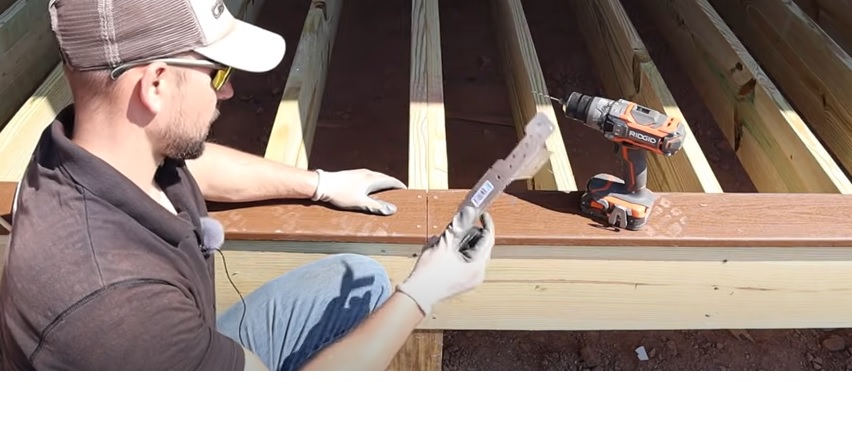In the fourth part of my article series on how to build a deck, I’m going to guide you through how to install Trex composite decking (see part 1, 2, and 3). This is the type of decking that I like to use, and I highly recommend it for your DIY house building project, as well.
Remember to ALWAYS CHECK YOUR LOCAL BUILDING CODES prior to starting a DIY home build of any kind.
What Is Trex Composite Decking?
Trex is a type of decking that is made of 95% recycled materials. It’s more durable and less likely to rot, splinter, or warp than traditional wood deck planks. It’s also resistant to termites and requires little maintenance.
One thing to note about Trex is that it’s flimsier than wood decking. But as long as you install it properly, it should last you for many years.
In case you were worried about not being able to find Trex in the right color, don’t be. Trex decking comes in several attractive wood grain finishes that will look beautiful with whatever color scheme you’ve chosen for your house.
Tools and Supplies Needed To Install Trex Composite Decking
DISCLAIMER – This article does contain affiliate links. I earn a small commission that helps support this website at no extra cost to you, if one of the links is used to make a purchase.
I’ve made a list of the tools and supplies you’ll need to install Trex composite decking below. You can find the specific brands that I use for each tool in the Excellent Laborer Amazon store.
- Trex composite deck boards (for this tutorial, I used the Trex Enhance Basics 16-ft Saddle Grooved Composite Deck Board)
- Trex hidden fasteners
- Trex brackets
- Composite decking screws
- Drill
- Hammer
- Saw
- Tape measure
- Chalk box
Step by Step Guide To Installing Trex Composite Decking
Note: Before you begin, square off the ends of your Trex decking boards using a saw. They don’t come completely square out of the package.
Step 1: Mark a chalk line across your deck joists to function as a guide for your first Trex board.
In my live demonstration of installing Trex decking, I wanted a ½” overhang for the outermost Trex board. Trex boards are 5 ½” wide, so I used my tape measure to mark 5” on the ledger board, lined the chalk box up with it, and snapped it to create a straight cross line across all the deck joists.

Step 2: Install the first row of Trex boards.
To begin this step, choose a board with a square edge instead of a grooved edge. Then, line up the edge of the board with the chalk line you made in step 1. Leave a ¼” gap between the end of the Trex and the side of the house to allow for the siding.
Next, pre-drill two holes on the end of the Trex where it rests on the ledger board, using an ⅛” bit.

Finally, use your drill to screw in two composite decking screws in the holes you made. (It’s important that you use these and not regular screws. Composite decking screws are designed not to harm composite decking like the Trex.) Countersink the screws flush with the top of the decking board.

Continue installing composite decking screws all along the first row of Trex boards to secure them into every joist in the deck.

Be sure to leave an ⅛” gap between the ends of the Trex boards that you install in a row. You can use a spacer like the one I used below to check your work.


Step 3: Install brackets behind the first row of Trex deck boards, so that you can start attaching groove edged boards in the second row.
To do this, take a ¼” wide shim and sandwich it between the square edged Trex board and the bracket, on top of a joist.

Next, take a drill with an ⅛” bit and pre-drill a hole where the bracket will sit in the joist. Then secure the bracket screw and remove the shim.


Repeat this process until you’ve installed a bracket on each joist in the decking.

Step 4: Slide the second row of Trex boards into place until it’s tight against the first row. The boards should have groove edges, not straight edges.

Remember to leave a ⅛” gap between the ends of the boards.
Step 5: Install Trex fasteners on each joist beneath the second row of Trex boards.


To do this, hold the Trex board you’re working on in place with your knee or a heavy object. Next, slide the fastener into the groove of the Trex board, so that it sits partially on top of the joist. Then screw it snug into place – but don’t tighten it completely.


Repeat this process for all the fasteners in the second row.

Step 6: Install the third row of Trex groove edge boards.
As you slide each new board up against the second row of boards, use a hammer and lightly tap on it to push it into place. Then install the new row of fasteners.


Once this is done, go back to the fasteners that sit between the second row and the third row of Trex boards and finish tightening them with your drill.

Waiting to tighten the fasteners until you’ve installed the next row of Trex boards gives you flexibility in case you need to straighten rows as you go along.
Pro Tip: Periodically use your tape measure to measure the distance from the house to the row of Trex you’re currently installing. Measure at different points along the decking and compare the results. This trick will help you make sure that you’re installing your rows on a straight line.

Step 7: Repeat steps 5 and 6 for every row of Trex decking until you reach the house.
Step 8: Secure the ends of each Trex board into place with your drill by repeating the same process you followed in step 2 for the first row of decking.


Step 9: Finish your decking by screwing the last board into place.
Place your screws ¼” from the side of the house into the ledger board wherever there’s a joist.
That’s it! Now you can enjoy the beautiful results.

Keep coming back to the Excellent Laborer blog to find more excellent tutorials, and subscribe to the Excellent Laborer YouTube channel to stay up to date on my latest DIY adventures.
